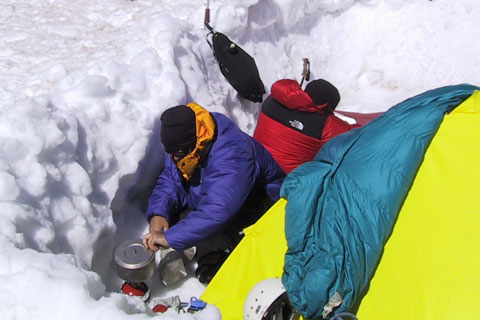| 331 | Winter Stoves | 2011-01-12 |

On our first trip to Mount Baker (Washington) Ray and I arrived at the Coleman Glacier in a whiteout. The strong, cold wind was our only company. Hastily, we dug a platform and sat up our very small tent. Long before we were able to get inside, we were very cold. The storm sapped all of our energy, but we still had to eat and drink. There was no way we were going back outside in that blizzard to cook. We had to cook inside the tent.
We knew the dangers of cooking inside the tent. Tents are flammable and carbon monoxide poisoning is possible from cooking inside any enclosed area. Our tent even had a warning label advising us not to cook in the tent; but whoever made up that rule was probably sitting in some cozy warm office and not freezing to death on Mount Baker!
Venting the doors we sat the small stove at the entrance of the tent in the vestibule. Attaching a new canister of gas we lit the blow torch. The flame made us smile, we would have water in minutes.
Suddenly, a gust of wind hit the tent and we began to gain a more clear understanding of why the tent manufacturers issued the stove warning. With quick hands we extinguished the fire. After a brief discussion we re-lit the stove. We had come very close to burning down the tent; but cooking in the tent was still our only option. Carefully, we kept vigil over the flame as we coaxed the stove into boiling water.
By the way, we barely made enough water to quench our thirsts and cook dinner. The stove was very slow and the freeze dried dinners were terrible.
From that trip and many other similar trips we have learned a few tricks to help in winter camping.
A few winter stove tips ...
- Practice using the stove before taking it on any trip.
- Know how to fix anything that could go wrong with the stove.
- White gas (Coleman Fuel) stoves are not as effected by the cold weather but are generally more dangerous to light.
- Canister stoves can be used but are not as reliable. You might have to warm the cartridge from time to time.
- Bring matches. Most lighters start acting funny in cold weather and/or higher altitudes.
- Piezo igniters also tend to be troublesome in the cold. Always bring good matches as a backup. We use the REI waterproof-windproof matches. They are mini-torches.
- A wind screen is a necessity.
- On longer trips, a heat exchanger might be useful.
- Make a base out of closed cell foam covered with aluminum foil to insulate the stove from the snow.
- More fuel is used in the winter. Making water is a time consuming process that requires a lot of fuel. If possible, get your water from creeks.
- Keep the meals as simple as possible. Boiling water is hard enough.
- Plan on hiking shorter distances. Arrive at camp with plenty of daylight. All chores take longer in the winter.
- Set up the kitchen. Bring a small lightweight tarp to help protect the kitchen area.
- Cook outside the tent.
- Pack clothing for cooking. Bring lightweight gloves that allow dexterity for cooking and a thick enough jacket insulating layer to keep you warm.
- Cooking is boring and often times cold work, share the duties.
If you absolutely have to cook inside the tent ...
- Be careful.
- Light the stove away from the tent.
- After the stove is burning smoothly place the stove in the vestibule by the door.
- Ventilate the tent.
- Keep an active watch on the flame.
- Be ready to toss the stove outside the tent, if a flare up occurs.
Cooking inside a tent is ill advised. Every time I have cooked inside a tent, it is because I made a bad decision and am having to live with the consequences. Good planning and decision making will almost always eliminate cooking inside the tent.
Stoves we use ...
- MSR XGJ - the expedition workhorse
- MSR Dragonfly - a strong stove that still simmers
- MSR WhisperLite - a dependable machine
- Jetboil - our favorite stove
- Snowpeak - small, lightweight, and slow - bring a good book!
- Gaz 470 - a strong canister stove, it is called the Primus Yellowstone Classic now
- Optimus 8R - we really don't use this one, or the Svea 123 anymore, they are just museum pieces
All the stoves are carried by REI (other than the 8R and 123).
Happy winter stove trails